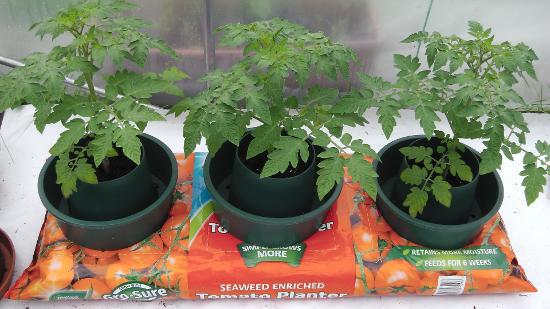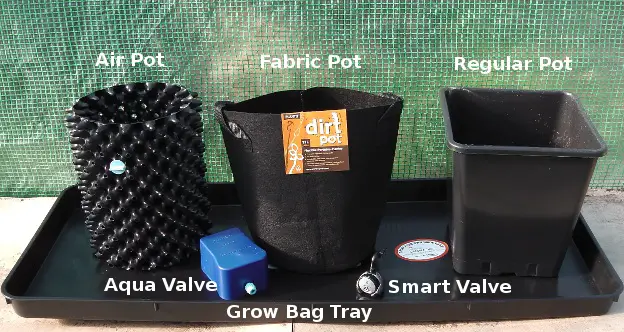In this Newsletter: Leggy tomato plants, grow pots, watering tips, the best way to feed tomatoes, when to start feeding tomatoes, the benefits of self watering planters.
As we approach the period of “final position planting” which is the end of May for growing tomatoes outside in the UK, or beginning of May in a greenhouse, there are a number of things we can do to “prepare the way” and optimise our efforts.
Leggy tomato plants

This is such a common problem, especially if seeds are sown a little too early.
It’s good to plant as deep as possible, removing the seed leaves and even the first true leaf branch if you can plant deep enough.
Roots will start to grow from the main stem, below soil, after about two weeks.
More about how to avoid and deal with leggy plants here.
Grow pots
It is difficult to plant deep if transplanting into a grow bag, although grow pots will provide extra depth of soil.
Grow pots are highly recommended for grow bags as they provide a separate inner ring for feeding and outer ring for watering. The feed doesn’t get washed away by plain water.

Watering tip
After the nutrients in the soil or potting compost have been used up by a plant, we usually add a general purpose food, or tomato food when watering.
Plain water will wash away the nutrients from around a plant’s roots!
So, if we feed once a fortnight and water every other day, our plants won’t be able to access the food they need on a regular basis.
The best way to feed
The ideal way to feed is to decrease the amount and increase the frequency – or in other words … little and often.
Some nutrients are depleted from the soil quicker than others as hungry plants require nitrogen (N) more than other nutrients in the early to middle stages. For this reason it is a good idea to continue with a balanced feed containing a good amount of nitrogen, rather than tomato feed with reduced nitrogen. We can feed with tomato food after the flowers begin to set fruit.

When to start feeding
If a grow bag has enough nutrients to feed three tomato plants for around five or six weeks, we won’t need to start feeding our toms until the first or second week of July, if we plant them at the end of May (outside).
Plants grown in a greenhouse will grow more quickly, owing to the more moderate and higher temperatures, so a grow bag will feed for a shorter period – around four or five weeks before the plants require feeding.
Of course it depend on the size of your grow bag … the average grow bag contains around 30 to 35 litres of soil. Super size grow bags contain 40 to 50 litres of soil, so we can add a week or two, to the timing above, before we start feeding when using the larger grow bags.
The most important consideration about feeding
In Holland they say: “Let the tomato plants tell you what they need” or something similar!
The point is … observation of a plant’s leaf colour will tell us if they are getting what they need and if there is a deficiency.
I talk to my plant’s regularly but I don’t expect them to answer back! 😉
Self watering planters (SWP’s)
The great thing about self watering planters is that they provide tomato plants with water and nutrients 24/7, whenever they want to drink and feed.
Also, it is possible to feed via the reservoir rather than adding all of the nutrients to the soil.
This helps avoid nutrient competition and excess in the soil. Some roots will grow down into the reservoir and take water and nutrients into a plant, avoiding the soil altogether!
It is possible to feed in three ways:
- Through the soil
- Through the reservoir
- Through the leaves – with a foliar spray
This flexibility of self watering planters, allows us to avoid a number of problems including nutrient lock up – when the excess of one nutrient blocks another from being absorbed through the roots.
Pots and grow bags
If you decide to use just basic pots or grow bags, it is a good idea to optimise them in some way.
Adding perlite, vermiculite, water gel crystals etc. helps to retain and hold more moisture in the soil – important on a hot day when plants are fruiting.
To avoid water logging, stick a few pencil holes through each end of a grow bag an inch above ground level.
If you poke holes in the sides of a grow bag, the water may flow out before the entire soil area is watered.
Grow bag trays are useful for making sure the soil is fully watered and great for standing pots in.

Air pots and fabric pots are very good for adding oxygen to the root zone (see respiration and tomato plants).
The soil in these pots tends to dry out a bit quicker, so sitting them in a tray with a watering valve is ideal, or watering them manually in a tray – from the bottom up – is good too.
If this is your first season growing tomatoes
If this is your first season growing tomatoes, you don’t need to have all these extra’s. In fact, it is a good idea to get some experience with the basic equipment, find out which varieties you like to grow and how you like to grow them.
It is about experimenting and learning along the way – finding out what works best for you, in your garden and in your part of the world.
Have a good week – I think wet weather is on the horizon for some of us!
Regards,
Nick

Valerie
No time to sow seed this year! First time in over thirty years I have not grown toms from seed so I bought the last two plants from Waitrose, Moneymaker and Sungold.
They seem fine and are currently in a conservatory but will go out onto a sunny patio when we get some sun.There are lots of different Toms for sale as plugs so may add a couple more plants,maybe a cherry variety.I .do hope anyone who no longer has a greenhouse or garden will not give up gardening when they downsize into retirement accomadation.
Nick
Hi Valerie,
There are so many more varieties available now as plug plants than there used to be!
I think more and more people will start with plug plants, especially if they don’t have the room and time to start from seed.
I receive emails from people who live in flats etc. and grow dwarf and trailing varieties on their balconies, so that’s encouraging!
Regards,
Nick
Rhys Jaggar
Magnesium is something I find my plants benefit from at rhis time, Nick.
I do not know exactly why, but they always perk up at 5-8 weeks old with a feed of Epsom salts.
When I pot on to 15cm pots, I also feed with seaweed solution from below, standing pots on a plastic tray. They perk up much quicker I find.
Final sowings are just emerging, one of three tubs now on windowsill with seedlings through, another 24hrs for the other two.
Nick
Hi Rhys,
A feed of Epsom salts is very good for greening up leaves – making the leaves a darker green and increasing sugar production in the leaves.
I’ve always found that seaweed solution is a great addition for healthy growth.
Regards,
Nick
Trevor Johnson
Hi Nick
What brand of High Nitrogen feed would you recommend?
Are chicken pellets any good?
Thanks
Trevor
Nick
Hi Trevor,
Chicken pellets are very good … I used to add a handful to the soil when potting into final position – gives quite a boost!
Nick
william forsyth
hi nick
my ferline plants are coming on fine , but rosella plants are very slow
Nick
Hi William,
Check the packed and sow by date on the back of the seed packet – maybe they are losing their vigour if they are older seed or perhaps the seed has been stored in a warm place (?).
Rob
Hi William,
I grow a range of tomatoes every year including Rosella and find seeds from different sources have different levels of vigour. Last year, I was so disappointed with a range of seeds I bought from one particular supplier that I will not use it again.
I know it’s a bit late for this year, but Rosella is such a lovely tomato that you might want to try seeds from a different supplier next year. Meanwhile, let’s hope for a bit of sunshine to help this year’s crop along!
Kind regards,
Rob